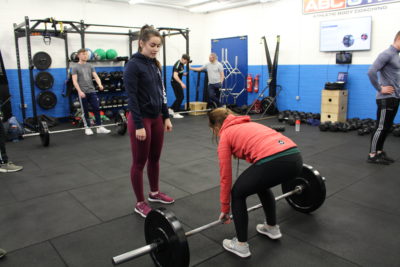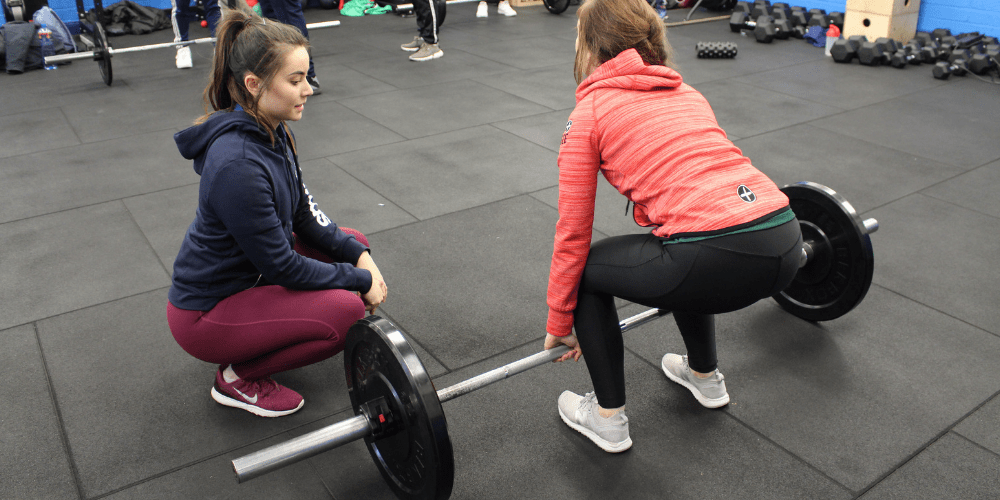Powerlifting involves trying to lift as heavy a weight as possible for a single repetition in three different lifts; the squat, the deadlift and the bench press. Powerlifting is a pure expression of maximal dynamic strength or the maximal amount of force the lifter can produce.
Powerlifting to many people is a sport that conjures up an image of gigantic people lifting ridiculously heavy weights and looking like they are about to pass out after every lift. In truth powerlifting is a sport that is enjoyed and participated in by many different types of people who vary massively in shape and size. This includes 19 year old, Leah Cheung.
From starting in a gym teen club aged 14, she never would have guessed she would be a three time record breaker and powerlifting champion.
Working closely with Coach Eamonn Harford, from Laoch Barbell, Leah works off of a weekly plan with daily check-ins regarding the weight prescribed. Currently in the run up to competition she does two compound movements then accessory work for the rest of the session.
“The other day I had my deadlift day so I had to do 122.5kg for 2 singles then, incline bench press, KB sumo deadlift to work on technique with my hips with planks at the end. It may seem easy on paper but doing it really takes it out of you! But I love the challenge each and every time,” states Leah.

Leah coaching her classmate at a Setanta College workshop in ABC gym.
As a student on our Diploma in Personal Training and Strength & Conditioning, she can now see the limitations people have in gyms and identifies how to correct their movements faults – which is something she never thought she’d be able to do.
Benefits you can expect from powerlifting:
For Leah, it clears her mind of any frustration because you have to focus on the weights. Also, you may not be sweating as much as in other sports but your body is still working hard. Powerlifting allows you to build muscle, burn fat and reduce the risk of injury in other sports or throughout daily life.
Powerlifting for athletes:
The field of strength and conditioning has been heavily influenced by powerlifting and the types of training that powerlifters perform. Strength and conditioning coaches often desire to build the maximal strength of athletes and increase their force output. Increases in maximal strength could translate to improved sporting performance and increase resilience to injury. So when looking for training methods to improve strength, the training methods of powerlifters is a logical place to learn from.
Of course athletes from sports other than powerlifting should not be trained like powerlifters and expected to excel at their sport as a result. Maximal strength will only be one of the physical capacities needed in many sports and athletes will need to train many other physical capacities that powerlifters do not have to worry about training. Even though athletes shouldn’t be trained as powerlifters, there is no doubt that powerlifting methods, techniques and programming hold some great training knowledge about the development of maximal strength in 3 of the main compound lifts that nearly every strength and conditioning training plan will include at some point.
So now we are just going to look at the three powerlifting exercises and give some tips for performing each exercise.
The Bench Press
• 5 points of contact – During the bench press the back of the head, the upper back and the tailbone/glutes will be in contact with the bench. Each foot will be in contact with the ground and this gives you your 5 points of contact. This 5 points of contact give a stable base for lifting and in powerlifting competitions you must maintain these 5 points of contact during the bench press lift or it will not be counted.
• Bar Path – During the bench press the bar will start over the upper back and be lower down to around nipple level to touch the chest (the touch position will differ for people based on a number of factors but it will be in this area). So the bar path is not a straight up and down line, it comes forward as it is lowered and is then pressed up and back to return to being directly over the upper back.
The Squat
• Keep the feet flat on the ground – Rising onto your toes, or lifting your toes off the ground as you sit back on your heel during a squat is not ideal for squat performance. Think of your big toe, little toe and heel as the points of a triangle. All points of the triangle should stay in contact with the ground throughout the squat
• Depth – For powerlifting depth of the squat is very important. The top surface of the legs must be lower than the knees at the bottom position for a squat to count in powerlifting. If you are struggling to hit depth try rotating your feet outwards and widening your stance. Also heel raises may help to achieve a greater depth if ankle mobility is an issue that is affecting squat depth.
The Deadlift
• For a sumo deadlift – begin with the bar loaded on the ground. People who do sumo tend to be more mobile with their hips. A lot of people who squat with low bar find it easy to transition to a sumo deadlift. Walk up to the bar and place your feet in a wide stance with your toes pointed outwards. You do not want to have your toes pointed forward because you will not have enough balance to execute the lift and your knees shouldn’t be caving in which is what having your toes pointed forward will do. So knees and toes pointing outwards with your upper body upright.
• Imagine you are trying to open up your hips and when you are lowering yourself to grip the bar. Wedge your body to the bar and you can do a double overhand grip (pronate grip) or an over-under grip (mixed grip). Make sure the bar is touching your shins.
• Brace your core, big breath in and roll the shoulders back slightly while pulling the slack out of the bar. Pull with your hips and legs and drive your chest up and open it. You don’t want to have your gluteus maximus too high because then you will be pulling more so with your lower back than your hips and legs.
Leah’s current PR’s are 115kg squat, 50kg bench in competition and deadlift 122.5kg outside of competition. Looking to 2019, her goal is to get a 140 kg deadlift, 125kg squat and a 60kg bench by the end of the year.
And for anyone thinking of trying out powerlifting, she has this to say, ” Just do it…if you want to do it and have been thinking of doing it, then you know you have to! If you’re paranoid about people in the gym – don’t be, everyone is just trying to work on themselves. So focus on you and improving YOU”.
Learn more about the courses available at Setanta College here, or contact a member of our team below.


Leave A Comment